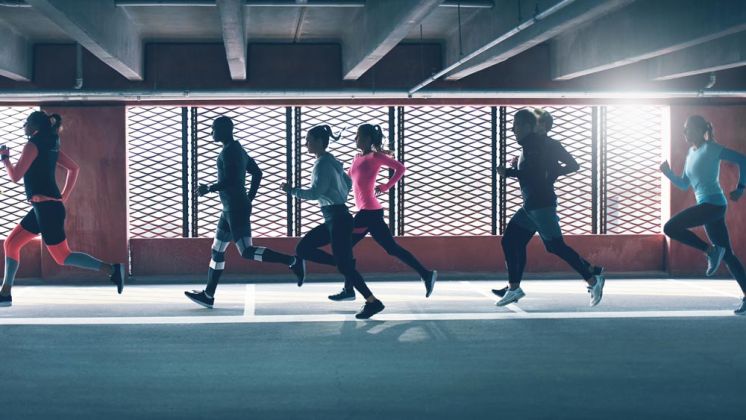Five Running Mistakes That Are Making You Slower
Expert advice to help you escape your running rut

When you first start running it’s easy to make huge improvements quickly. Just running regularly is enough to make you faster, giving you plenty of motivation to keep going.
After a while, however, the improvements stop coming so readily and, horror of horrors, you might even find that you start to slow down. When this happens it can become tempting to give up running altogether. Don’t! Instead, simply make some adjustments to your running routine and you’ll soon be flying along faster than ever.
Personal trainer and running coach Matt Kendrick has teamed up with Macmillan Cancer Support to provide advice on avoiding the standard mistakes that cause most runners to plateau – and you can put these tips into practice immediately by signing up for Macmillan OutRun May.
In this month-long event, participants sign up to achieve a certain goal over the course of May. You can choose any target distance you like or try to hit one of the recommended goals: 10-30 miles for beginners, 30-80 miles for intermediate runners, or 80+ miles for the more experienced. Decide on your goal, then sign up at out-run.org.uk and start fundraising.
Before you take a single step, however, read through Kendrick’s tips for avoiding the five most common running mistakes.
1. Not Warming Up (Or Getting Your Warm-Up Wrong)
“Many people wrongly think that a little jog counts as a warm-up and lots of others don’t bother warming up at all. This is a huge mistake. Millions of office workers spend hours sat at their desks every day, which makes your muscles very tight. It means that when you set off on a run after work, without warming up efficiently, it puts more strain on the tight muscles and ends up placing more stress on your joints, which can lead to injuries.
“Before you run make sure you mobilise your glutes, hip flexors, calves and ankles with dynamic movements such as high knees, forward lunges and bodyweight squats. Ideally before doing these you’d start by foam rolling your thighs, hips and hamstrings. By activating these muscles you’ll find you will be able to run a lot faster and be less prone to injuries.”
Sign up for workout ideas, training advice, reviews of the latest gear and more.
RECOMMENDED: How To Warm Up For A Run
2. Doing Nothing But Running
“Time and time again I see runners whose only exercise is running. The problem with this is that you are working the same muscles repeatedly and not doing anything to strengthen the other muscles.
“This is one of the common causes of injuries such as runner’s knee, which is a dull pain in the outside of the knee caused by tight and overworked muscles. The key to making your legs more powerful and faster lies in strength training. Swap one run a week for a workout that incorporates squats, lunges, deadlifts and core work.”
RECOMMENDED: Strength Training For Runners
3. Running Too Much
“Going hell for leather and running every day is a surefire way to injure yourself and zap the fun out of exercise. In fact, less is often more. Our muscles repair, recover and get stronger when they have time to rest and rebuild, and so it is vital that we always put time aside for our bodies to rejuvenate.
“Pilates is a fantastic addition to any exercise regime because it strengthens the core and gives your muscles a deep stretch. Foam rolling and sports massages are also great for repairing the body, as are baths with magnesium salts. Don’t skimp on sleep either – aim for seven to eight hours a night to get the most out of your workouts.”
RECOMMENDED: How To Sleep Better
4. Getting Your Nutrition Wrong
“Fuelling your body correctly is extremely important so make sure you are eating enough food, particularly protein to help build muscle and the right kind of carbohydrates to give you energy. Aim for wholegrain carbohydrates that will sustain your energy levels throughout your training.
“If you know you are doing a big run in the morning have a balanced meal for dinner the night before. If you are running after work make sure you eat a lunch with protein and carbohydrates, as well as a healthy snack a couple of hours beforehand.
“It’s just as important to stay hydrated too, so aim to drink around two litres of water every day. This will give you more energy and help you push through any plateaus.”
RECOMMENDED: What To Eat Before A Run
5. Wearing Incorrect Footwear
“Everyone’s running style is different – some people’s feet roll inward as they run (pronation), some feet roll outwards (supination) and others are neutral. The shoes you wear need to suit your individual running style.
“Do your research before investing in footwear and, just as importantly, replace them when they are worn out. A lot of specialist running shops are now fitted with treadmills, so staff can fit you with exactly the right shoe for you – they’ll be able to analyse your running style and find a trainer that complements it.”
RECOMMENDED: The Best Running Shoes

Nick Harris-Fry is a journalist who has been covering health and fitness since 2015. Nick is an avid runner, covering 70-110km a week, which gives him ample opportunity to test a wide range of running shoes and running gear. He is also the chief tester for fitness trackers and running watches, treadmills and exercise bikes, and workout headphones.
